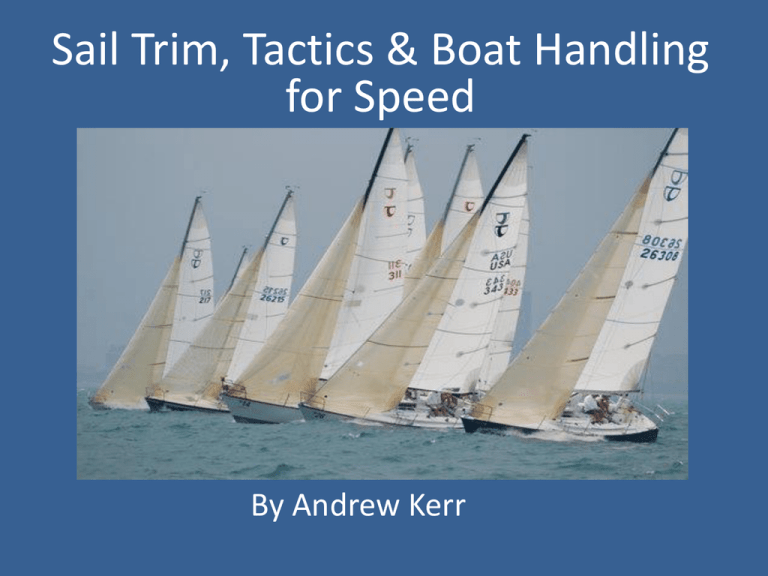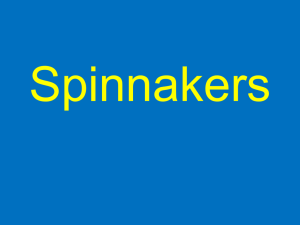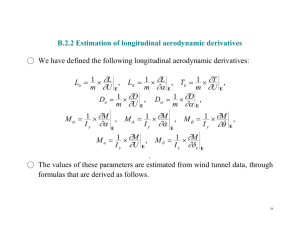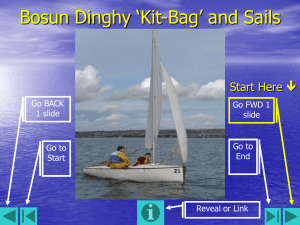Sail trim for speed in all conditions. By Andrew kerr
advertisement

Sail Trim, Tactics & Boat Handling for Speed . By Andrew kerr By Andrew Kerr Tuning before the start – set up the critical settings and split tacks Rig tension – light Air • In light air watch the leeward shrouds – if they are taught then the rig is too tight , set it up for the lulls and lots of power Watch the leeward shrouds – how loose are they ? How much forestay sag ? Try a spinnaker halyard to the forestay as a reference. Key Elements upwind – Mainsail trim • At the start- set up for power, note the 3 baton positions on mainsail across the range of conditions – Open, closed, open again. • Light Air Upwind : – Set up the sail for twist - ventilate the leech – have a fast mark on the mainsheet. – Ease the Mainsail halyard to open the top of Set up for power off the line Key Elements upwind in light air - Jib Trim • Soft Jib/ Genoa Halyard – keep evaluating. • Ease in the Lifts to help the speed and gain the lift Upwind Light/ medium air set up in chop/ swell – some sag for power. Trim the sails together, ease and squeeze . Roll tack the boat – but be sure not to pre roll as it unloads the boat. Roll tacking Speed build out of tacks with both leeches open and then closed as up to speed. Medium air Medium Air Trim • If smooth water Trim the mainsheet on so the top baton is parallel to the boom or 2 to 3 degrees to weather for pointing. • Set up for the lulls not the puffs – set the rig up half a setting looser than the tuning guide. Medium air trim • If choppy set the boat up with more twist to help deal the changing apparent windle angle changes . Medium air Trim • If there is too much forestay sag the mainsail will luff early – backstay on or tighten the forestay and/ or shrouds. • Play the backstay like a throttle for power – be sure to set it from the premise of max hiking on the rail Medium Air Trim Mainsail trim in medium air – flat water Medium air trim – flat water Contrast in Mainsail leech tensions – which looks best ? Jib trim – Medium air – flat water. Halyard tension effects leech profile . Heavy air Trim Heavy air Trim • • • • • • • • • Max outhaul Max Backstay Tight Cunningham Rigid forestay Tight vang – “ Vang sheeting” Traveler down Very tight Jib halyard for draft forward shape Jib leads aft a small amount Ease headsail in gusts in tandem with mainsail to keep the slot consistent. Minimum Forestay sag Heavy air Trim • Play the traveller to keep the boat at a constant angle of heel • If the traveller becomes exhausted as a vehicle of balance, or the gusts are coming in very quickly or you have a short traveller consider Vang Sheeting . Heavy air mantra – constant angle of heel. Twist ! Heavy air Trim with the Jib • If sailing with the small jib – be sure to not over sheet it and ease it slightly in the gusts to keep the slot consistent and the boat tracking • Make sure the halyard is really tight so that you can ease the sheet and still maintain the leech profile Out hike the other teams ! Hiking Key elements for a big fleet • Get off the line in the front row with a gap to leeward - go for a low density area. • Sail fast unhindered by other boats until you decide to tack and consolidate. • Meet the fleet later in the leg when it has thinned out and the lanes are wider. T10 NA’s 2010 Starting pictures – T10 NAC 2009 Starting pictures – T10 NAC 2009 Starting pictures – T10 NAC - 2007 Weather Mark rounding Rounding the weather mark • Be smooth – keep weight on the rail as long as you can • Ease the Vang slightly prior to the rounding • Be sure to ease the main out fluidly and quickly to help the bear away Sailing to an Offset Sailing to an offset mark – right shift Sailing to an offset mark • Sail the boat well between the marks • Sight the offset mark – where is it, how far and what angle ? Can we set the spinnaker? Do we have to beat to it? ( left shift) Downwind Trim Have the pole height or tack line set to a fast Mark • Have the Vang set to a fast mark • Assume the right angle as soon as possible – the trimmer should immediately be talking to the skipper about pressure on the sheet • Assume the correct angle immediately – the trimmer should be talking pressure on the sheet all the time Downwind trim – Key elements • Play the pole height in puffs and lulls – raise up in the puffs to get more projection , lower the pole to induce stability in the sail • Playing the vang & watching the top baton carefully – 3 modes : • Low mode – top baton open 3 to 5 degrees • Average – parallel to the boom • Rolling – enough o stop rolling If overpowered on a reach- weight aft, go with a bigger curl on the luff , play the vang and leave the backstay on. Spinnaker Pole height • Watch where the luff breaks Spinnaker Pole height – Light Light air pole height with puffs Spinnaker pole height – Medium air Pole height in light/ medium air, center seam is vertical – look back for shifts/ puffs as you sail to the line. Spinnaker pole Height medium air Spinnaker pole height – medium air – vertical profile Spinnaker pole height – Heavy air – lower to spill leech. Weight distributed with neutral helm Downwind weight placement • Make sure the crew is distributed low and to the sides so the boat steers itself. • Particularly in light air get as many crew out of the cockpit to reduce drag in the stern and reduce wetted surface • In marginal conditions – big puffs and lulls – make sure the crew is moving for and aft so the stern doesn't sink in the lulls or the bow is buried in puffs. Downwind – heel to weather Heavy air trim & technique Heavy air downwind • Over sheet the spinnaker to prevent rolling • Twing down on both sides to stop the spinnaker oscillating • Lower the pole to spill the upper leech • Make sure there is enough vang on to stop rolling • Steer under the spinnaker center seam to keep the boat upright Ease the……… !! Pole down – free fly Weather takedown – weather heel Spinnaker takedowns - Windward • Set mainsail controls for upwind • Headsail up, keep eased, set halyard tension • Pole down – guy back, heel to weather & bear off Windward takedown Leeward mark rounding • If rounding alone (Clear air) – sail VMG • Critical to trim the sails properly for the rate of turn – particularly light air where the sails want to be trimmed for every point of sail. • Be sure to trim the Genoa strictly to the telltales Halyard drop – “stretch and blow” Tighten the sheet , dump the halyard ! Gather the sail in with the middle of the foot, only then release the guy. Light air rounding – weight to leeward and slow trim on the sails Leeward mark rounding – good sail trim Medium air rounding Out of the rounding – jump in to your mode – VMG, Fast forward or high mode Conclusion • Two boat tuning raises both teams • Be careful of not over trimming – stalled sails take twice as long to reattach flow as sails on the verge of luffing • Really focus on the critical settings before the start so you are optimized off the starting line • As much - if not more to be gained shifting gears in the lulls as well as the puffs. • The more you keep your head out of the boat the better.











